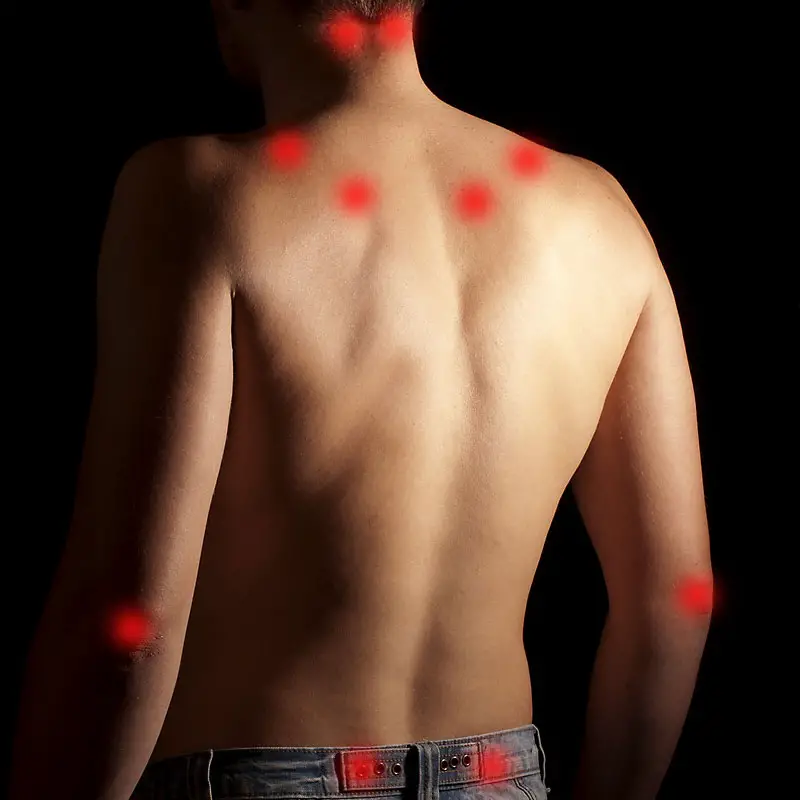If the phrase "The pain never goes away even with time, but you just learn to live with it" was meant to illustrate a disease, it probably corresponded to fibromyalgia. Indeed, fibromyalgia, or diffuse idiopathic polyalgia syndrome (SIPD), is considered a chronic pain syndrome.
Long misunderstood, this disease still maintains today many conflicts as to the real symptoms as well as the treatment of the latter (1).
The objective of this article is to approach this pathology from a therapeutic and scientific. Thus, we will begin with a brief explanation of this pathology before addressing its diagnosis and treatment according to the latest scientific advances.
That you are professional, patient or just a simple curious, this article should answer many questions!
Pathology (introduction to pathology)
Prevalence of this pathology
Fibromyalgia, a rheumatic pathology, affects 2 to 4% of the general population and represents 14% of patients with rheumatic pathologies (with in this category psoriasis, rheumatoid arthritis, etc.) Among the diseases with chronic pain, fibromyalgia is the second most prevalent (prevalent = frequently encountered) (2). In France, 1,4% of the population would suffer from it! This represents approximately 680,000 people (3)!!
Among the patients carrying this disease, there would be a clear predominance in women since they represent 80% of the patients affected and age would be a determining factor since the peak of onset of the disease is between 40 and 50 years (1 ).
Impact of this pathology in patients
If this pathology remains infrequent, its impact should not be underestimated. Typically, patients present with pain and diminished ability functional (to carry out daily activities) that can encroach on the professional but also social life of the person. The subject's quality of life is therefore reduced. Another important point is the evolution of this disease. Indeed, in the long term, it changes little: 4 years after diagnosis, 97% of people are still considered to have fibromyalgia and for 60% of them, the condition has worsened.
Thus, we see that the evolution of this pathology is not to be taken lightly, but neither is the diagnosis! Indeed, studies have been able to show that the multiplicity of symptoms, in opposition to a reliable clinical examination leads to medical wandering of the patient who can sometimes wait up to 2 years before a reliable diagnosis is offered to him!
Also, we will note that other conditions are frequently encountered such as psychiatric and neurological disorders, overweight or trough (which is present in 20 to 30% of patients). The psycho-affective component is therefore important (4)
Important point
Finally, a important point to understand for patient, therapist and l'entourage of the patient is that in this pathology, patients find themselves in a position where their body seems unknown to them with sensations that do not always have a particular meaning: pain, fatigue, etc.
Le lack of regularity of the symptoms can lead to overloads of activity one day that they will pay almost systematically the next day by an increase in symptoms.
Thus, people's daily lives become more or less unpredictable and are regulated by symptoms. The continuity between body, mind and society seems broken for the patient (5)
Thus, we therefore understand that this complex pathology and linking the psychic and somatic side must be able to be diagnosed reliably in order to be treated early and effectively!
The diagnosis
What is the patient showing?
Generally, the patient makes the diagnosis with his doctor (although sometimes the physiotherapist being more frequently encountered than the doctor, it is he who may realize this for the first time).
Thus, the patient usually presents with the triad symptomatic next : pain (chronic and diffuse with a duration of more than 3 months), general fatigue, sleep disturbances. To this trinomial can be added other symptoms such as mood disorders, cognitive, digestive, ENT or even urogynecological disorders (1)
Let us now substantiate the symptomatic triad:
- -The pain : they generally appear in the form insidious (that is to say in a benign form and hiding the real gravity) but also in a brutal way after an accident for example. The effort aggravates the pain with sometimes a hyperalgesia (the pain is increased for the same stimulus) or a allodynia (pain is felt for a normally non-painful stimulus). It also seems interesting to note that the first places of pain frequently reported are: lower back pain, migraines and headaches (6).
- -Tiredness : Appearing in 90% of cases, it limits daily activities and is influenced by the stress suffered by the patient.
- -The sleeping troubles : these disorders are defined as sleep non-recovery with untimely awakenings that may be accompanied by restless leg syndrome or sleep apnea.
For the therapist, the diagnosis of fibromyalgia is highly probable when the history shows a female subject with pain for more than 3 months, sleep disturbances, general fatigue, cognitive disorders, sensory or visceral complaints, correspondence to criteria from the American College of Reumatology or FIRST and when theclinical and biological examination are normal (1)
How to assess a patient?
In order for the therapist to carry out a diagnosis and a quality assessment, he will have to evaluate all the dimensions of the pathology and of his patient. In order to help him, many tools can be used! We will list these tools without describing them and taking into account that this is not an exhaustive list.
- -The severity of fibromyalgia: evaluation of the symptomatic triad and the impact of the disease on the daily life of the patient. The therapist can use the following questionnaire: the figs(or Fibromyalgia Impact Questionnaire).
- -General physical condition: it is necessary to evaluate the activities person's physical arrangements of achievement and effects of this activity on the symptoms. Some authors also suggest carrying out a stress test!
- - Sleep disorders: the quality of sleep will be an important point! If one of the best evaluations remains the polysomnography, it is not always possible to access it! Thus, some questionnaires make it possible to assess the sleep such as Pittsburgh Sleep Quality Index or drowsiness as'Epworth Sleepiness Scale.
- -Comorbidities (or aggravating factors): We can assess the trough (with questionnaires like the SNAKE, Beck Depression Inventory (Intergovernmental Panel on Climate Change) and the Hamilton Depression Scale). Also, the evaluation of cognitive disorders and emotional responses is to be done.
- -The motivation of the patient: the evaluation of the motivation through the stages of decisional maturation of Prochaska allow the therapist to guides, the patient as best as possible.
I have back pain, is it fibromyalgia?
If you or one of your patients has back pain, particularly lumbar pain, it is not necessarily associated with fibromyalgia. Indeed, some studies have looked at these two phenomena. And even if lumbar pain presents itself early in many fibromyalgia patients(6), this pain is characterized by hyperalgesia linked to mechanical stimuli (touch or movement) but also to heat (something that we do not not frequently found in pure low back pain sufferers) (7). Also, if in doubt, performing a FIRST can eliminate any doubts quickly.
Treatment
Medical or physiotherapy treatment (in physiotherapy)?
Regarding medical treatment, severe pain can be treated with medications: Duloxetine, Pregabalin, Tramadol (with Paracetamol). Severe sleep disorders, meanwhile, will be treated with Amitriptyline, Cyclobenzaprine or Pregabalin (8). If it does not fall within the scope of physiotherapists (physiotherapists), medical treatment is no less important and is complementary to our practice.
Physiotherapy treatment, what to offer?
While many therapies could be offered to our patients, only a few of them have been the subject of quality studies and have benefited from scientific recognition. Among these are:
- -Physical activity : Cornerstone of treatment, it can be implemented in the form of aerobic activity (or endurance) or muscle strengthening. The intensity should be moderate but sufficient in duration and frequency. A good modality would be the practice of exercise at the Ventilation Threshold 1 (which corresponds to a small jogging where one begins to have difficulty in discussing with his neighbor). The combination of aerobic exercises, strengthening and stretching (or relaxation) would be a good idea according to several studies (2)
- -Cognitive and behavioral therapies : These therapies aim to identify and modify the cognitive processes and behaviours which may be detrimental to the patient's pain or limitations. From a cognitive point of view, the patient can be offered to reinforce the perceived control of his pain or to learn to distract himself from the attention he pays to the pain, for example. From a behavioral point of view, we can propose graduated exposure in situation (9)
- -Other Effective Ways : acupuncture and electro acupuncture (8,10), meditation (8,11)
And apart from that?
Apart from the treatments previously proposed, some therapies could be applied despite the lack of evidence : we think in particular of manual therapy with massage (and myofascial relaxation in particular), psychological care and patient education (5,10,12,13). Hydrotherapy remains a controversial point even if one remains tempted to propose it.
Conversely, hypnotherapy, chiropractic, biofeedback, ultrasound and other lasers do not seem to be effective (8).
What is the purpose of doing all this?
As said in the introduction, the continuity between body, mind and society seems broken for the patient. Thus, if our objective cannot be the complete cure of the patient, all the therapies proposed must have the objective ofimprove the condition and quality of life of the patient. This will allow him to find a certain continuity between his body, his mind and society.
For more information or in case of doubt, do not hesitate to contact me by email (see below) or directly on Instagram!
If you want to benefit from a structured, simplified and complete approach to combating your back pain, a series of ONLINE GUIDES is made available to you. Whatever your condition, you will find a guide who will meet your needs and guide you on the path to recovery.
Projects
- 1. Guinot M, Launois S. Fibromyalgia: pathophysiology and therapeutic support. EMC – Physiotherapy – Phys Medicine – Rehabilitation. 2014;
- 2. Ángel García D, Martínez Nicolás I, Saturno Hernández PJ. “Clinical Approach to Fibromyalgia: Synthesis of Evidence-based Recommendations, a Systematic Review.” Reumatol Clínica Engl Ed. 2016 Mar;12(2):65–71.
- 3. Bannwarth B, Blotman F, Branco J, Cerinic MM, Carbonell J, Martinez IF, et al. Prevalence of fibromyalgia in Europe. Rev Rum. 2007 Nov;74(10–11):1105–6.
- 4. Adam P, Le Tyrant A, Lejoyeux M. Psychosomatic approach to affectionsrheumatology. EMC – Locomotor Apparatus. 2011 Jan;6(1):1–9.
- 5. Mengshoel AM, Grape HE. Rethinking physiotherapy for patients withfibromyalgia – lessons learned from qualitative studies. Phys Ther Rev. 2017 Nov 2;22(5–6):254–9.
- 6. Santiago V, Raphael K. (337) Medical Comorbidities in a FibromyalgiaCommunity Sample. J Bread. 2019 Apr;20(4):S59.
- 7. Blumenstiel K, Gerhardt A, Rolke R, Bieber C, Tesarz J, Friederich HC, et al.Quantitative Sensory Testing Profiles in Chronic Back Pain Are Distinct From Those inFibromyalgia: Clin J Pain. 2011 Oct;27(8):682–90.
- 8. Macfarlane GJ, Kronisch C, Dean LE, Atzeni F, Häuser W, Fluß E, et al. EULARrevised recommendations for the management of fibromyalgia. Ann Rheum Dis. 2017Feb;76(2):318–28.
- 9. Master JH, Crouan A. Therapeutic approaches to pain inphysiotherapy. Physiotherapy Rev. 2017 Jun;17(186):56–70.
- 10. Salazar AP de S, Stein C, Marchese RR, Plentz RDM, Pagnussat ADS. ElectricalStimulation for Pain Relief in Patients with Fibromyalgia: A Systematic Review andMeta-analysis of Randomized Controlled Trials. Bread Physician. 2017;20(2):15–25.
- 11. Wang C, Schmid CH, Rones R, Kalish R, Yinh J, Goldenberg DL, et al. A Randomized Trial of Tai Chi for Fibromyalgia. N Engl J Med. 2010 Aug 19;363(8):743–54.
- 12. Person M. Physiotherapy decision: Laurence. Fibromyalgia. PhysiotherapyRev. 2015 Aug;15(164–165):14–9.
- 13. Yuan SLK, Matsutani LA, AP Marks. Effectiveness of different styles of massage therapy in fibromyalgia: A systematic review and meta-analysis. Man Ther. 2015 Apr;20(2):257–64.





